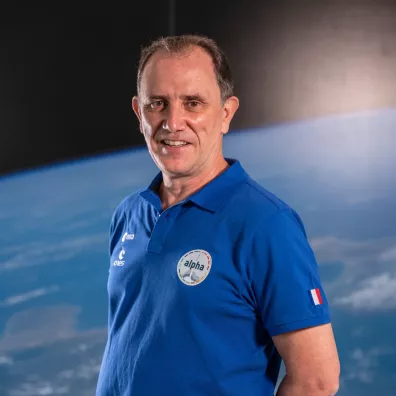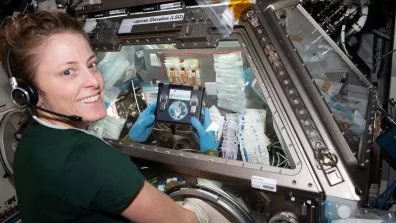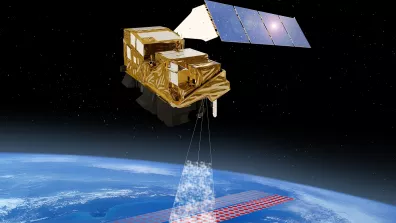Culturing cerebral organoids on the ISS
After spending 40 days aboard the International Space Station (ISS), the cerebral organoids returned to Earth at the end of December 2023. These human-derived cerebral structures cultured in the lab are the first organoids ever to be grown in space (others had only previously spent time there).
"They came back alive and in good shape,” says Frank Yates, a lecturer and research scientist at the SupBiotech engineering school. “We’re really pleased with the mission; it’s been a great success.”
The experiment, called Cerebral Ageing, has shown for the first time that cerebral organoids can be grown in space.
It’s a step change for scientific research in this field!

Initiated in 2019, Cerebral Ageing is a cellular biology experiment developed by the CADMOS centre for the development of microgravity applications and space operations at CNES (see box below), the Institut Pasteur, SupBiotech and BioServe Space Technologies.
Son objectif ? Établir un modèle pour étudier le vieillissement du cerveau à très petite échelle, celle de la cellule et même de la molécule. L’analyse de ces structures permet aux scientifiques de mieux comprendre ce qui se passe dans un cerveau vieillissant.
Its aim is to build a model for studying ageing processes in the brain at the cellular and molecular scale. Analysing these structures allows scientists to better understand what happens in an ageing brain. “Numerous experiments are performed on samples—blood samples, for example—from astronauts,” notes Miria Ricchetti. “But it’s impossible to study a piece of the human brain, which is why we use cerebral organoids to mimic the structure and composition of a developing brain.”

Miniature cerebral structures derived from human cells
How do scientists go about producing cerebral organoids? They cultivate them in vitro in the lab from multipotent human stem cells, which can differentiate into almost any cell in the human body. They simply need to be grown in a specific environment to differentiate into a heart, muscle or other cell, or in the case of Cerebral Ageing, into several neural cells (those found in a human brain or organoid). Once they have proliferated and differentiated sufficiently into several types of cells structured in well-defined layers, they form an organoid. “They are 3D structures made up of different types of structured and interacting cells, like a human brain in early development,” explains Miria Ricchetti. For Cerebral Ageing, the science team cultured several hundred cerebral organoids, 84 of which were sent to the ISS.

Space is a very useful environment for scientific investigation, as microgravity and cosmic radiation have an effect on living organisms. “Our hypothesis is that such conditions accelerate the ageing process,” abounds Frank Yates. “We’re among the first to have sent organoids cultured for so long into space.” Cerebral Ageing therefore aims to demonstrate the ability to send living or immobile cerebral organoids into space, to grow them there and then recover them. The ISS offers a unique environment for this experiment, in orbit at an altitude of 400 kilometres and dedicated to microgravity science since 1998.
How the organoids fared aboard the ISS
Growing organoids in space is no easy task, but the team overcame all obstacles put in their path. “We know how to grow them in the lab, but the experiment conditions on the ISS were new for us, involving a lot a biotechnological engineering work,” says Frank Yates. Didier Chaput, life science experiment lead at CADMOS (CNES), confirms: “Our role was to support the science teams from the earliest stages of the project to accomplish it in the conditions of space. That way, they can focus on doing the science.” With the team at BioServe, CNES made sure all the hardware for the experiment was on the ISS.
Step one: fabricate cerebral organoids and test the experiment’s feasibility
“Readying an experiment for the ISS involves optimizing the resources you have to reduce costs, save space and make the best use of astronaut time devoted to the experiment during the flight,” explains Didier Chaput. On the ground, organoids no larger than a few millimetres were cultured and grown in specially designed cell culture cassettes supplied by the U.S. firm Bioserve. These first tests were successful, validating the experiment’s feasibility on the ground in conditions as close to flight conditions as possible and clearing the way to send it to the ISS.
Step two: fly organoids to ISS
384 organoids were placed inside two hermetically sealed containers maintaining a constant temperature of 37°C and a level of CO2 of 5%. Such conditions are vital to keep the organoids alive. The two incubators were shipped to Kennedy Space Center at Cape Canaveral, Florida. 84 carefully selected organoids were then placed in the 14 flight cassettes with the culture medium and delivered to NASA just hours before the launch of the Falcon 9 vehicle on 9 November 2023. Organoids that didn’t make the cut continued to develop on the ground as controls.

Step three: conduct scientific experiment aboard ISS
This step was one of the most important, and it proved tricky. Three astronauts carried out the experiment on board the ISS: Lora O'Hara (NASA), Jasmin Moghbeli (NASA) and Andreas Mogensen (ESA).
“To survive, the organoids need nutrients, which means their culture medium has to be changed,” explains Frank Yates. “For the first time ever, we succeeded in doing this for cerebral organoids, while refreshing the medium as infrequently as possible to avoid taking up valuable crew time.”

The cassettes have a syringe for the astronaut to inject fresh culture, and another syringe to suck out spent medium. The crew followed a strict scientific protocol: certain organoids were immobilized at three specific times (two days after arriving aboard the ISS, mid-mission and before returning to Earth). “They’re either frozen or ‘fixed’ using a specific product,” notes Miria Ricchetti. “That allows us to analyse their condition so we can see how they’ve evolved over time.”

Step four: bring organoids back to Earth
As planned, 12 live organoids were brought back from the station in the same conditions as the outward trip. Those that had been fixed were placed in refrigerated containers at 4°C or –80°C.
Getting the organoids back to the science team alive was a huge relief and a sign of the mission’s success despite the many surprises thrown at us. Thanks to the rigorous protocol, the results are robust and are set to advance science.

Astronaut health and Alzheimer’s disease
The science team is now busily working on the last phase of the project, analysing all of the samples brought back to France since February 2024. Three types of measurements are being performed. The organoids are cut into thin slices and observed under the microscope to determine cell health and composition. Genetic analyses will also be performed using state-of-the-art tools. Lastly, the spent culture medium was also brought back to Earth: “the molecules the organoids release into medium—called metabolites—tell us about their health,” explains Miria Ricchetti. And to ascertain the effects of their stay in space, the team has another trick up its sleeve: “We grew other cerebral organoids at the same time on Earth to serve as controls.”
The organoids are set to reveal their first secrets by the end of this year. The results will notably enable scientists to begin investigating the effects of spaceflight exposure on avatars of astronaut brains, a vital prerequisite for future space exploration and to protect crews on long-duration missions.
If ageing proves to be accelerated in space, growing cerebral organoids opens the door to exciting research for teams working on degenerative disorders like Alzheimer’s disease.

By observing molecular and cellular changes in an ageing organoid, scientists will gain new insights into how degenerative disorders develop. We haven’t heard the last of cerebral organoids…
crucial support from CADMOS
Here on Earth, the CADMOS centre for the development of microgravity applications and space operations is a key ally for scientists looking to conduct experiments in microgravity. An operational unit of CNES based at the Toulouse Space Centre since 1993, it helps them to ready their experiments, monitors them once in flight and collects data obtained. Under the coordination of the European and U.S. space agencies, CADMOS offers scientists unique test platforms like the International Space Station and the Airbus Zero-G parabolic flight aircraft.





